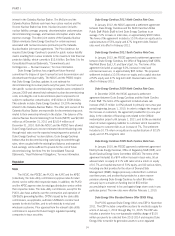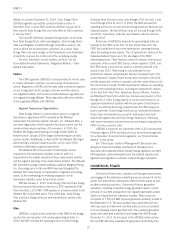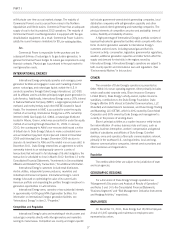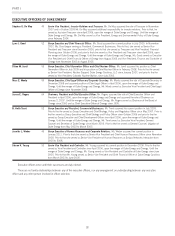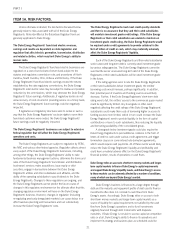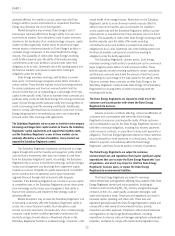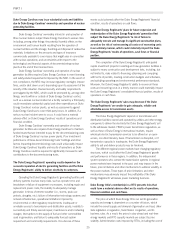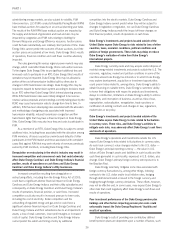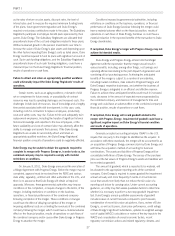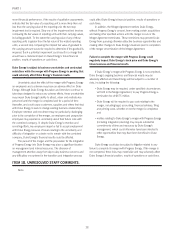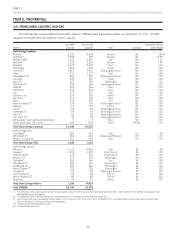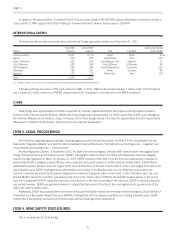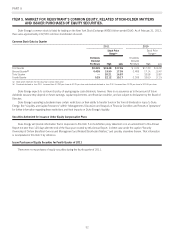Duke Energy 2011 Annual Report Download - page 42
Download and view the complete annual report
Please find page 42 of the 2011 Duke Energy annual report below. You can navigate through the pages in the report by either clicking on the pages listed below, or by using the keyword search tool below to find specific information within the annual report.
PART I
adversely affected. An inability to access capital may limit Duke
Energy’s ability to pursue improvements or acquisitions that Duke
Energy may otherwise rely on for future growth.
Market disruptions may increase Duke Energy’s cost of
borrowing or adversely affect Duke Energy’s ability to access one or
more financial markets. Such disruptions could include: economic
downturns; the bankruptcy of an unrelated energy company; capital
market conditions generally; market prices for electricity and gas;
terrorist attacks or threatened attacks on Duke Energy’s facilities or
unrelated energy companies; or the overall health of the energy
industry. The availability of credit under Duke Energy’s revolving
credit facilities depends upon the ability of the banks providing
commitments under such facilities to provide funds when their
obligations to do so arise. Systematic risk of the banking system and
the financial markets could prevent a bank from meeting its
obligations under the facility.
Duke Energy maintains revolving credit facilities to provide
back-up for commercial paper programs and/or letters of credit at
various entities. These facilities typically include borrowing sublimits
for certain subsidiaries and financial covenants which limit the
amount of debt that can be outstanding as a percentage of the total
capital for the specific entity. Failure to maintain these covenants at a
particular entity could preclude Duke Energy from issuing commercial
paper or Duke Energy and the particular entity from issuing letters of
credit or borrowing under the revolving credit facility. Additionally,
failure to comply with these financial covenants could result in Duke
Energy being required to immediately pay down any outstanding
amounts under other revolving credit agreements.
The Subsidiary Registrants rely on access to short-term intercompany
borrowings and longer-term capital markets to finance the Subsidiary
Registrants’ capital requirements and support their liquidity needs,
and the Subsidiary Registrants’ access to those markets can be
adversely affected by a number of conditions, many of which are
beyond the Subsidiary Registrants control.
The Subsidiary Registrants’ businesses are financed to a large
degree through debt and the maturity and repayment profile of debt
used to finance investments often does not correlate to cash flows
from the Subsidiary Registrants’ assets. Accordingly, the Subsidiary
Registrants rely on access to short-term borrowings via Duke Energy’s
money pool arrangement and financings from longer-term capital
markets as a source of liquidity for capital requirements not satisfied
by the cash flow from its operations and to fund investments
originally financed through debt instruments with disparate
maturities. If the Subsidiary Registrants are not able to access capital
at competitive rates or the Subsidiary Registrants cannot obtain short-
term borrowings via the money pool arrangement, their ability to
finance their operations and implement their strategy could be
adversely affected.
Market disruptions may increase the Subsidiary Registrants’ cost
of borrowing or adversely affect the Subsidiary Registrants’ ability to
access one or more financial markets. Such disruptions could
include: economic downturns; the bankruptcy of an unrelated energy
company; capital market conditions generally; market prices for
electricity and gas; terrorist attacks or threatened attacks on the
Subsidiary Registrants’ facilities or unrelated energy companies; or the
overall health of the energy industry. Restrictions on the Subsidiary
Registrants’ ability to access financial markets may also affect its
ability to execute its business plan as scheduled. An inability to
access capital may limit the Subsidiary Registrants’ ability to pursue
improvements or acquisitions that it may otherwise rely on for future
growth. The availability of credit under Duke Energy’s revolving credit
facilities depends upon the ability of the banks providing
commitments under such facilities to provide funds when their
obligations to do so arise. Systematic risk of the banking system and
the financial markets could prevent a bank from meeting its
obligations under the facility agreement.
The Subsidiary Registrants’ ultimate parent, Duke Energy,
maintains revolving credit facilities to provide back-up for commercial
paper programs and/or letters of credit at various entities. These
facilities typically include borrowing sublimits for certain subsidiaries
and financial covenants which limit the amount of debt that can be
outstanding as a percentage of the total capital for the specific entity.
Failure to maintain these covenants at either Duke Energy or the
Subsidiary Registrants could preclude Duke Energy or the Subsidiary
Registrants from issuing letters of credit or borrowing under the
revolving credit facility.
The Duke Energy Registrants are exposed to credit risk of the
customers and counterparties with whom the Duke Energy
Registrants do business.
Adverse economic conditions affecting, or financial difficulties of,
customers and counterparties with whom the Duke Energy
Registrants do business could impair the ability of these customers
and counterparties to pay for the Duke Energy Registrants’ services or
fulfill their contractual obligations, including loss recovery payments
under insurance contracts, or cause them to delay such payments or
obligations. The Duke Energy Registrants depend on these customers
and counterparties to remit payments on a timely basis. Any delay or
default in payment could adversely affect the Duke Energy
Registrants’ cash flows, financial position or results of operations.
The Duke Energy Registrants are subject to numerous
environmental laws and regulations that require significant capital
expenditures that can increase the Duke Energy Registrants’ cost
of operations, and which may impact or limit the Duke Energy
Registrants’ business plans, or expose the Duke Energy
Registrants to environmental liabilities.
The Duke Energy Registrants are subject to numerous
environmental laws and regulations affecting many aspects of the Duke
Energy Registrants’ present and future operations, including air
emissions (such as reducing NOx,SO
2mercury and greenhouse gas
emissions in the U.S.), water quality, wastewater discharges, solid
waste and hazardous waste. These laws and regulations can result in
increased capital, operating, and other costs. These laws and
regulations generally require the Duke Energy Registrants to obtain and
comply with a wide variety of environmental licenses, permits,
inspections and other approvals. Compliance with environmental laws
and regulations can require significant expenditures, including
expenditures for cleanup costs and damages arising from contaminated
properties, and failure to comply with environmental regulations may
22




